Flexural Response of Concrete Specimen Retrofitted with PU Grout Material: Experimental and Numerical Modeling
Abstract
:1. Introduction
2. Materials and Methods
2.1. Materials
2.2. Specimen Preparation
2.3. Test Methodology
2.3.1. NC Compressive Test
2.3.2. The NC-PUG Flexural Test
3. Result and Discussion
3.1. Flexural Response of NC-PUG
3.2. Finite Element Modeling of NC-PUG Beam
3.3. Boundary Conditions, Loading Analysis, and Interaction
3.4. Element Type and Mesh Size
3.5. Contact Modeling
3.6. Material Constitutive Model
3.7. Material Constitutive Model of NC
3.8. Model Validations
4. Conclusions
- The configuration and/or position of the PU grout material cast influenced the relationship between the flexural stress and mid-span deflection. Specimens retrofitted at the bottom surface exhibit two deformation regions.
- The effect of the PU grouting material changes the brittle nature of concrete to a more ductile state due to the viscoelastic behavior of polyurethane. This behavior is more effective on the specimen retrofitted at the bottom surface.
- The FE analysis showed good agreement between the numerical model and the experimental test result. The numerical model accurately predicted the flexural strength of the NC-PUG beam, slightly underestimating Ke by 4% and overestimating Pu by 3%.
Author Contributions
Funding
Institutional Review Board Statement
Data Availability Statement
Acknowledgments
Conflicts of Interest
References
- Aabid, A.; Ibrahim, Y.E.; Hrairi, M.; Ali, J.S.M. Optimization of Structural Damage Repair with Single and Double-Sided Composite Patches through the Finite Element Analysis and Taguchi Method. Materials 2023, 16, 1581. [Google Scholar] [CrossRef] [PubMed]
- Aabid, A. Optimization of Reinforcing Patch Effects on Cracked Plates Using Analytical Modeling and Taguchi Design. Materials 2023, 16, 4348. [Google Scholar] [CrossRef] [PubMed]
- Al-shawafi, A.; Zhu, H.; Haruna, S.I.; Bo, Z.; Laqsum, S.A.; Borito, S.M. Impact resistance of ultra-high-performance concrete retrofitted with polyurethane grout material: Experimental investigation and statistical analysis. Structures 2023, 55, 185–200. [Google Scholar] [CrossRef]
- Park, D.; Park, S.; Seo, Y.; Noguchi, T. Water absorption and constraint stress analysis of polymer-modified cement mortar used as a patch repair material. Constr. Build. Mater. 2012, 28, 819–830. [Google Scholar] [CrossRef]
- Assaad, J.J. Development and use of polymer-modified cement for adhesive and repair applications. Constr. Build. Mater. 2018, 168, 139–148. [Google Scholar] [CrossRef]
- Zaccardi, Y.A.V.; Alderete, N.M.; De Belie, N. Improved model for capillary absorption in cementitious materials: Progress over the fourth root of time. Cem. Concr. Res. 2017, 100, 153–165. [Google Scholar] [CrossRef]
- Alderete, N.M.; Zaccardi, Y.A.V.; De Belie, N. Mechanism of long-term capillary water uptake in cementitious materials. Cem. Concr. Compos. 2020, 106, 103448. [Google Scholar] [CrossRef]
- Ohama, Y. Recent progress in concrete-polymer composites. Adv. Cem. Based Mater. 1997, 5, 31–40. [Google Scholar] [CrossRef]
- Giustozzi, F. Polymer-modified pervious concrete for durable and sustainable transportation infrastructures. Constr. Build. Mater. 2016, 111, 502–512. [Google Scholar] [CrossRef]
- Shao, J.; Zhu, H.; Zuo, X.; Lei, W.; Mirgan, S.; Liang, J.; Duan, F. Effect of waste rubber particles on the mechanical performance and deformation properties of epoxy concrete for repair. Constr. Build. Mater. 2020, 241, 118008. [Google Scholar] [CrossRef]
- Afzal, A.; Kausar, A.; Siddiq, M. Role of polymeric composite in civil engineering applications: A review. Polym. Technol. Mater. 2020, 59, 1023–1040. [Google Scholar] [CrossRef]
- Pendhari, S.S.; Kant, T.; Desai, Y.M. Application of polymer composites in civil construction: A general review. Compos. Struct. 2008, 84, 114–124. [Google Scholar] [CrossRef]
- Liu, G.; Otsuka, H.; Mizuta, Y.; Shimitsu, A. A foundational study on static mechanical characteristics of the super lightweight and high strength material using fly-ash. J. Soc. Mater. Sci. Jpn. 2006, 55, 738. [Google Scholar] [CrossRef]
- Hussain, H.K.; Zhang, L.Z.; Liu, G.W. An experimental study on strengthening reinforced concrete T-beams using new material poly-urethane-cement (PUC). Constr. Build. Mater. 2013, 40, 104–117. [Google Scholar] [CrossRef]
- Li, B.; Wang, F.; Fang, H.; Yang, K.; Zhang, X.; Ji, Y. Experimental and numerical study on polymer grouting pretreatment technology in void and corroded concrete pipes. Tunn. Undergr. Space Technol. 2021, 113, 103842. [Google Scholar] [CrossRef]
- Fang, H.; Li, B.; Wang, F.; Wang, Y.; Cui, C. The mechanical behaviour of drainage pipeline under traffic load before and after polymer grouting trenchless repairing. Tunn. Undergr. Space Technol. 2018, 74, 185–194. [Google Scholar] [CrossRef]
- Haruna, S.I.; Zhu, H.; Jiang, W.; Shao, J. Evaluation of impact resistance properties of polyurethane-based polymer concrete for the repair of runway subjected to repeated drop-weight impact test. Constr. Build. Mater. 2021, 309, 125152. [Google Scholar] [CrossRef]
- Jiang, W.; Zhu, H.; Haruna, S.I.; Shao, J.; Yu, Y.; Wu, K. Mechanical properties and freeze–thaw resistance of polyurethane-based polymer mortar with crumb rubber powder. Constr. Build. Mater. 2022, 352, 129040. [Google Scholar] [CrossRef]
- Al-Atroush, M.E.; Shabbir, O.; Almeshari, B.; Waly, M.; Sebaey, T.A. A Novel Application of the Hydrophobic Polyurethane Foam: Expansive Soil Stabilization. Polymers 2021, 13, 1335. [Google Scholar] [CrossRef]
- Liu, K.; Tong, J.; Huang, M.; Wang, F.; Pang, H. Model and experimental studies on the effects of load characteristics and polyurethane densities on fatigue damage of rigid polyurethane grouting materials. Constr. Build. Mater. 2022, 347, 128595. [Google Scholar] [CrossRef]
- Ibrahim, Y.E.; Nabil, M. Assessment of structural response of an existing structure under blast load using finite element analysis. Alex. Eng. J. 2019, 58, 1327–1338. [Google Scholar] [CrossRef]
- Shahbeyk, S.; Hosseini, M.; Yaghoobi, M. Mesoscale finite element prediction of concrete failure. Comput. Mater. Sci. 2011, 55, 1973–1990. [Google Scholar] [CrossRef]
- Słowik, M.; Nowicki, T. The analysis of diagonal crack propagation in concrete beams. Comput. Mater. Sci. 2012, 52, 261–267. [Google Scholar] [CrossRef]
- Guo, L.-P.; Carpinteri, A.; Roncella, R.; Spagnoli, A.; Sun, W.; Vantadori, S. Fatigue damage of high performance concrete through a 2D mesoscopic lattice model. Comput. Mater. Sci. 2009, 44, 1098–1106. [Google Scholar] [CrossRef]
- Hála, P.; Perrot, A.; Vacková, B.; Kheml, P.; Sovják, R. Experimental and numerical study on ballistic resistance of polyurethane-coated thin HPFRC plate. Mater. Today Proc. 2023. [Google Scholar] [CrossRef]
- Niu, S.; Wang, Z.; Wang, J.; Wang, D.; Sun, X. Experimental investigation on flexural performance of polyester polyurethane concrete steel bridge deck composite structure. Case Stud. Constr. Mater. 2023, 18, e01915. [Google Scholar] [CrossRef]
- Goushis, R.; Mini, K.M. Finite element analysis of polymeric and cementitious materials to secure cracks in concrete. Mater. Today Proc. 2022, 49, 1599–1606. [Google Scholar] [CrossRef]
- Li, M.; Xue, B.; Fang, H.; Zhang, S.; Wang, F. Variable angle shear test and finite element simulation of polyurethane—Bentonite composite structure. Structures 2023, 48, 1722–1729. [Google Scholar] [CrossRef]
- Sing, L.K.; Yahaya, N.; Valipour, A.; Zardasti, L.; Azraai, S.N.A.; Noor, N.M. Mechanical properties characterization and finite element analysis of epoxy grouts in repairing damaged pipeline. J. Press. Vessel Technol. 2018, 140, 61701. [Google Scholar] [CrossRef]
- Ai, S.; Tang, L.; Mao, Y.; Liu, Y.; Fang, D. Numerical analysis on failure behaviour of polyurethane polymer concrete at high strain rates in compression. Comput. Mater. Sci. 2013, 69, 389–395. [Google Scholar] [CrossRef]
- Chen, B.; He, M.; Huang, Z.; Wu, Z. Long-tern field test and numerical simulation of foamed polyurethane insulation on concrete dam in severely cold region. Constr. Build. Mater. 2019, 212, 618–634. [Google Scholar] [CrossRef]
- Moslemi, A.; Neya, B.N.; Davoodi, M.-R.; Dehestani, M. Proposing and finite element analysis of a new composite profiled sheet deck—Applying PU and PVC and stability considerations. Structures 2021, 34, 3040–3054. [Google Scholar] [CrossRef]
- Somarathna, H.M.C.C.; Raman, S.N.; Mohotti, D.; Mutalib, A.A.; Badri, K.H. Behaviour of concrete specimens retrofitted with bio-based polyurethane coatings under dynamic loads. Constr. Build. Mater. 2021, 270, 121860. [Google Scholar] [CrossRef]
- Li, X.; Wang, M.; Zheng, D.; Fang, H.; Wang, F.; Wan, J. Study on the failure mechanism between polyurethane grouting material and concrete considering the effect of moisture by digital image correlation. J. Build. Eng. 2023, 67, 105948. [Google Scholar] [CrossRef]
- Huang, H.; Li, M.; Yuan, Y.; Bai, H. Theoretical analysis on the lateral drift of precast concrete frame with replaceable artificial controllable plastic hinges. J. Build. Eng. 2022, 62, 105386. [Google Scholar] [CrossRef]
- Huang, H.; Huang, M.; Zhang, W.; Pospisil, S.; Wu, T. Experimental investigation on rehabilitation of corroded RC columns with BSP and HPFL under combined loadings. J. Struct. Eng. 2020, 146, 4020157. [Google Scholar] [CrossRef]
- Zhang, W.; Liu, X.; Huang, Y.; Tong, M.-N. Reliability-based analysis of the flexural strength of concrete beams reinforced with hybrid BFRP and steel rebars. Arch. Civ. Mech. Eng. 2022, 22, 171. [Google Scholar] [CrossRef]
- ABAQUS. ABAQUS Standard User’s Manual, Version 6.14; Dassault Systèmes: Providence, RI, USA, 2014. [Google Scholar]
- Jiang, W.; Zhu, H.; Haruna, S.I.; Zhao, B.; Shao, J.; Yu, Y. Effect of crumb rubber powder on mechanical properties and pore structure of polyurethane-based polymer mortar for repair. Constr. Build. Mater. 2021, 309, 125169. [Google Scholar] [CrossRef]
- Laqsum, S.A.; Zhu, H.; Bo, Z.; Haruna, S.I.; Al-shawafi, A.; Borito, S.M. Static properties and impact resistance performance of U-shaped PU-modified concrete under repeated drop-weight impact load. Arch. Civ. Mech. Eng. 2023, 23, 227. [Google Scholar] [CrossRef]
- GB/T50081-2002; Standard for Test Method of Mechanical Properties on Ordinary Concrete. China Academy of Building Research: Beijing, China, 2012.
- Somarathna, H.M.C.C.; Raman, S.N.; Mohotti, D.; Mutalib, A.A.; Badri, K.H. Rate dependent tensile behavior of polyurethane under varying strain rates. Constr. Build. Mater. 2020, 254, 119203. [Google Scholar] [CrossRef]
- Somarathna, H.; Raman, S.N.; Mohotti, D.; Mutalib, A.A.; Badri, K.H. Hyper-viscoelastic constitutive models for predicting the material behavior of polyurethane under varying strain rates and uniaxial tensile loading. Constr. Build. Mater. 2020, 236, 117417. [Google Scholar] [CrossRef]
- Haruna, S.I.; Zhu, H.; Ibrahim, Y.E.; Shao, J.; Adamu, M.; Farouk, A.I.B. Experimental and Statistical Analysis of U-Shaped Polyurethane-Based Polymer Concrete under Static and Impact Loads as a Repair Material. Buildings 2022, 26, 1986. [Google Scholar] [CrossRef]
- Al-kahtani, M.S.M.; Zhu, H.; Haruna, S.I.; Shao, J. Evaluation of Mechanical Properties of Polyurethane-Based Polymer Rubber Concrete Modified Ground Glass Fiber Using Response Surface Methodology. Arab. J. Sci. Eng. 2022, 48, 4695–4710. [Google Scholar] [CrossRef]
- Dassault, A. 6.14-Abaqus Analysis User’s Manual; Dassault Systèmes Simulia Corp.: Providence, RI, USA, 2014. [Google Scholar]
- Farouk, A.I.B.; Zhu, J.; Yuhui, G. Finite element analysis of the shear performance of box-groove interface of ultra-high-performance concrete (UHPC)-normal strength concrete (NSC) composite girder. Innov. Infrastruct. Solut. 2022, 7, 212. [Google Scholar] [CrossRef]
- Lee, J.; Fenves, G.L. Plastic-Damage Model for Cyclic Loading of Concrete Structures. J. Eng. Mech. 1998, 124, 892–900. [Google Scholar] [CrossRef]
- EN 1992-1-1; Eurocode 2: Design of Concrete Structures—Part 1-1: General Rules and Rules for Buildings. British Standard Institution: London, UK, 2004.
- GB50010-2010; Code for Design of Concrete Structures. National Standard of China: Beijing, China, 2010.
- Béton, C.E.-I.D. CEB-FIP Model Code 1990: Design Code; Thomas Telford Publishing: London, UK, 1993. [Google Scholar]
- ACI 318M-05; Building Code Requirements for Structural Concrete and Commentary. American Concrete Institute: Farmington Hills, MI, USA, 2005.
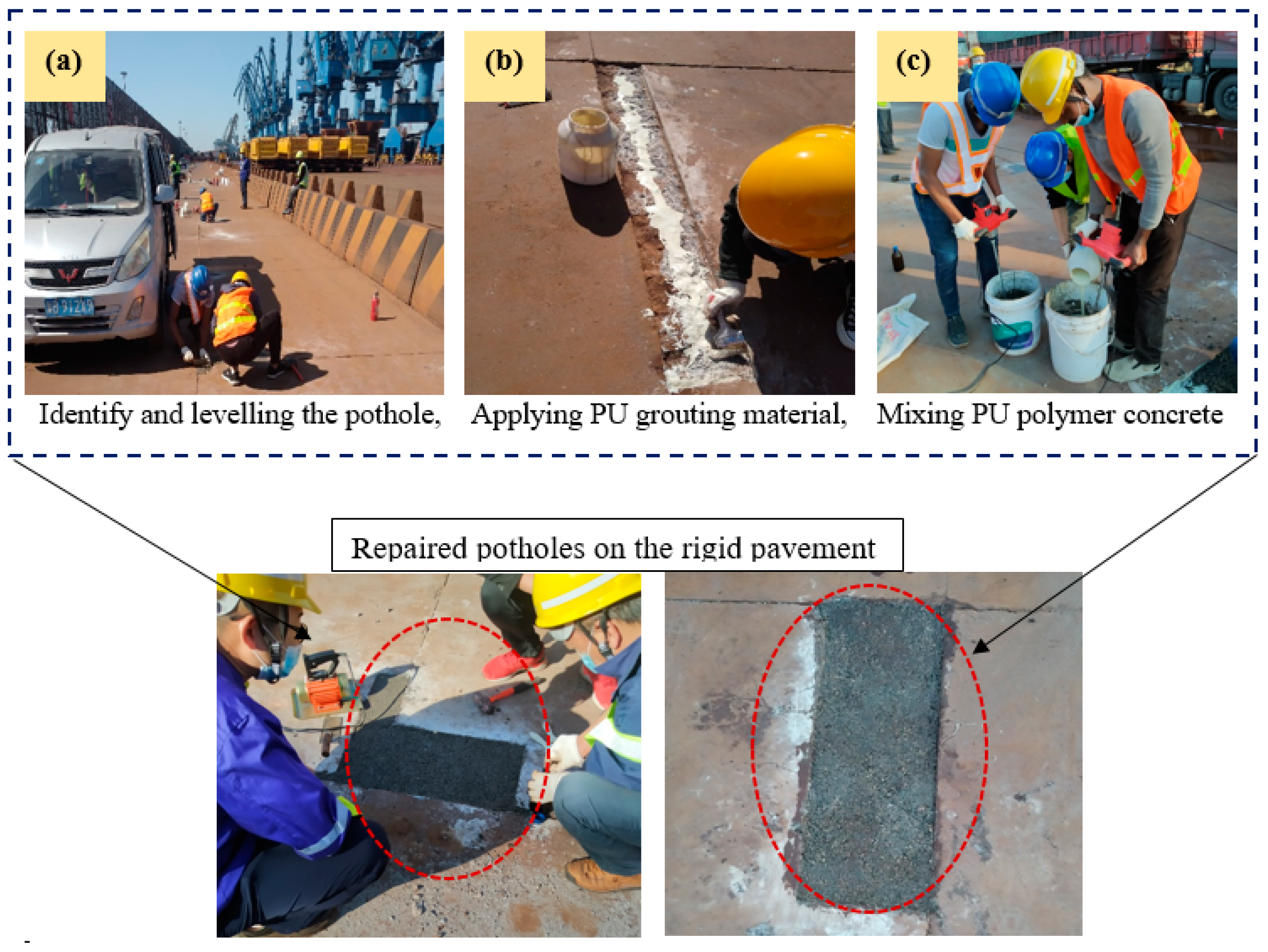
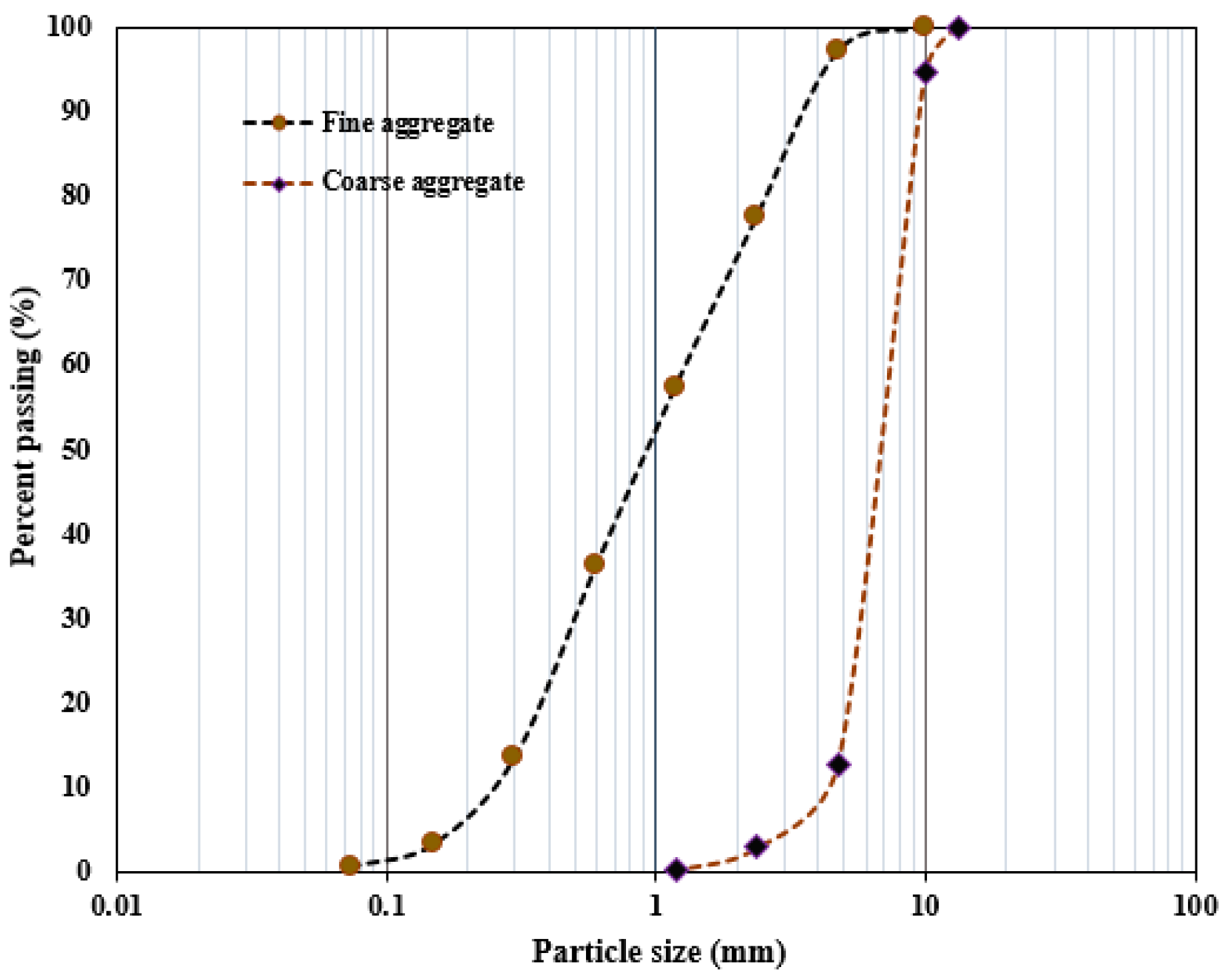


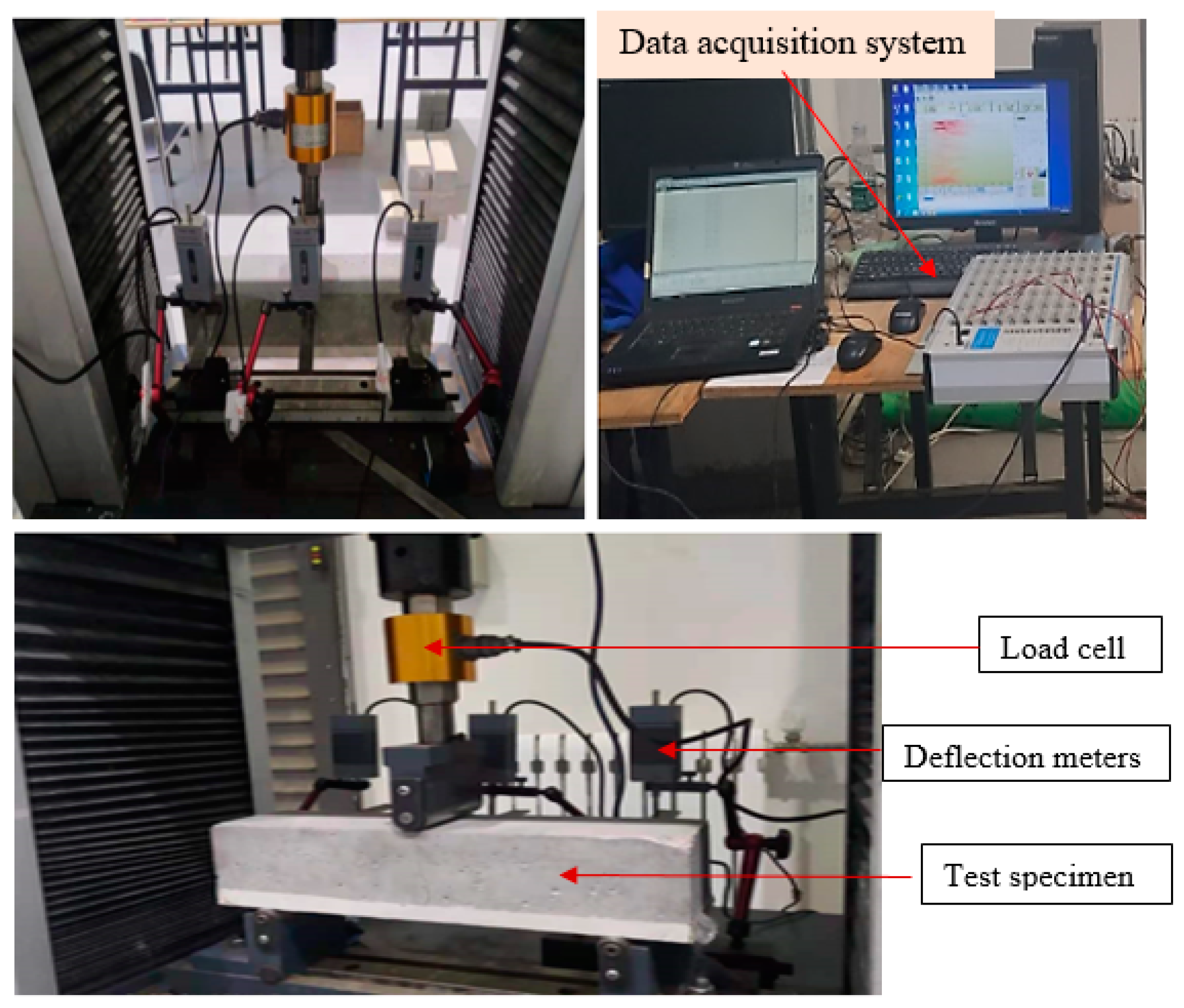
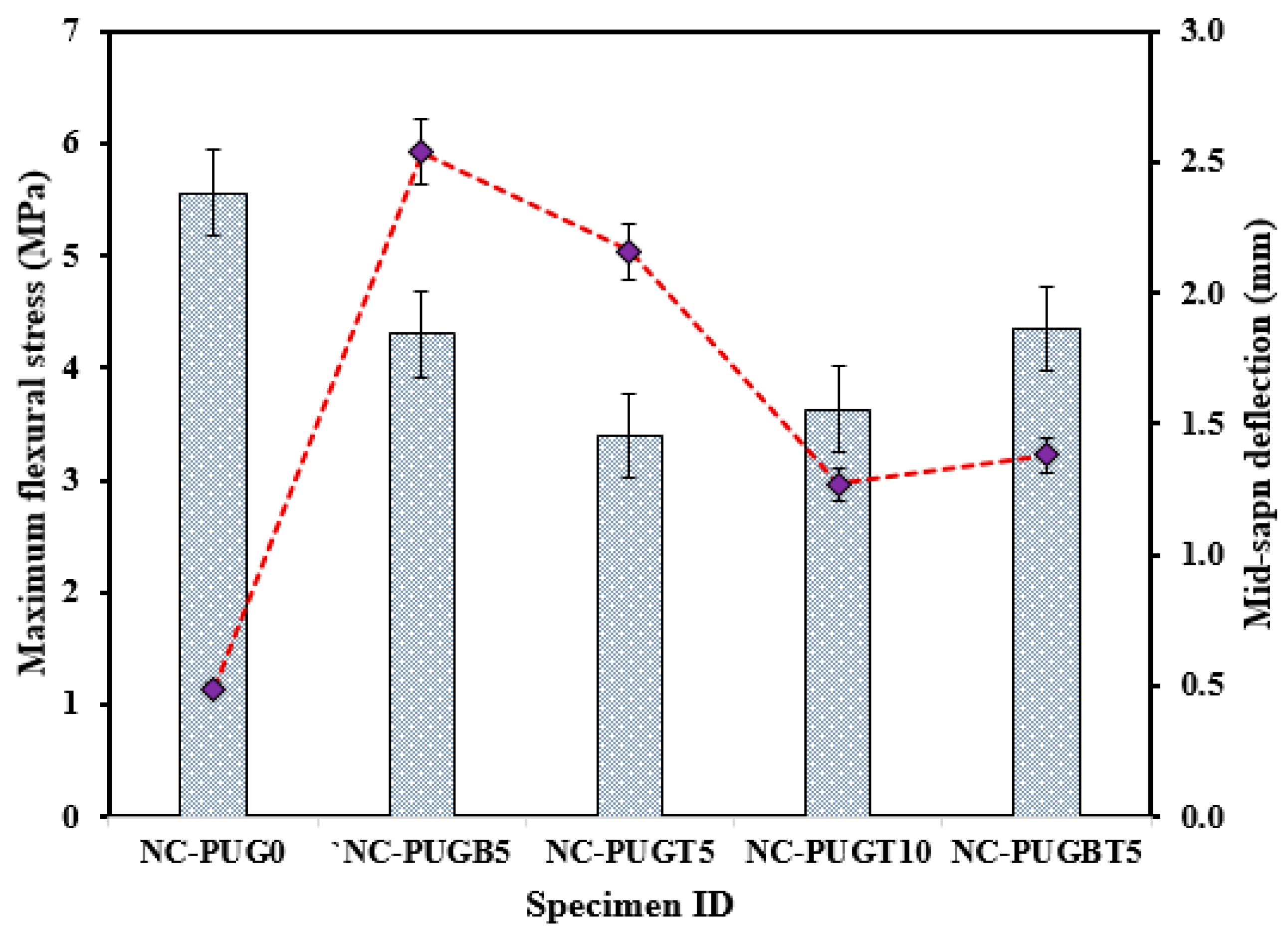
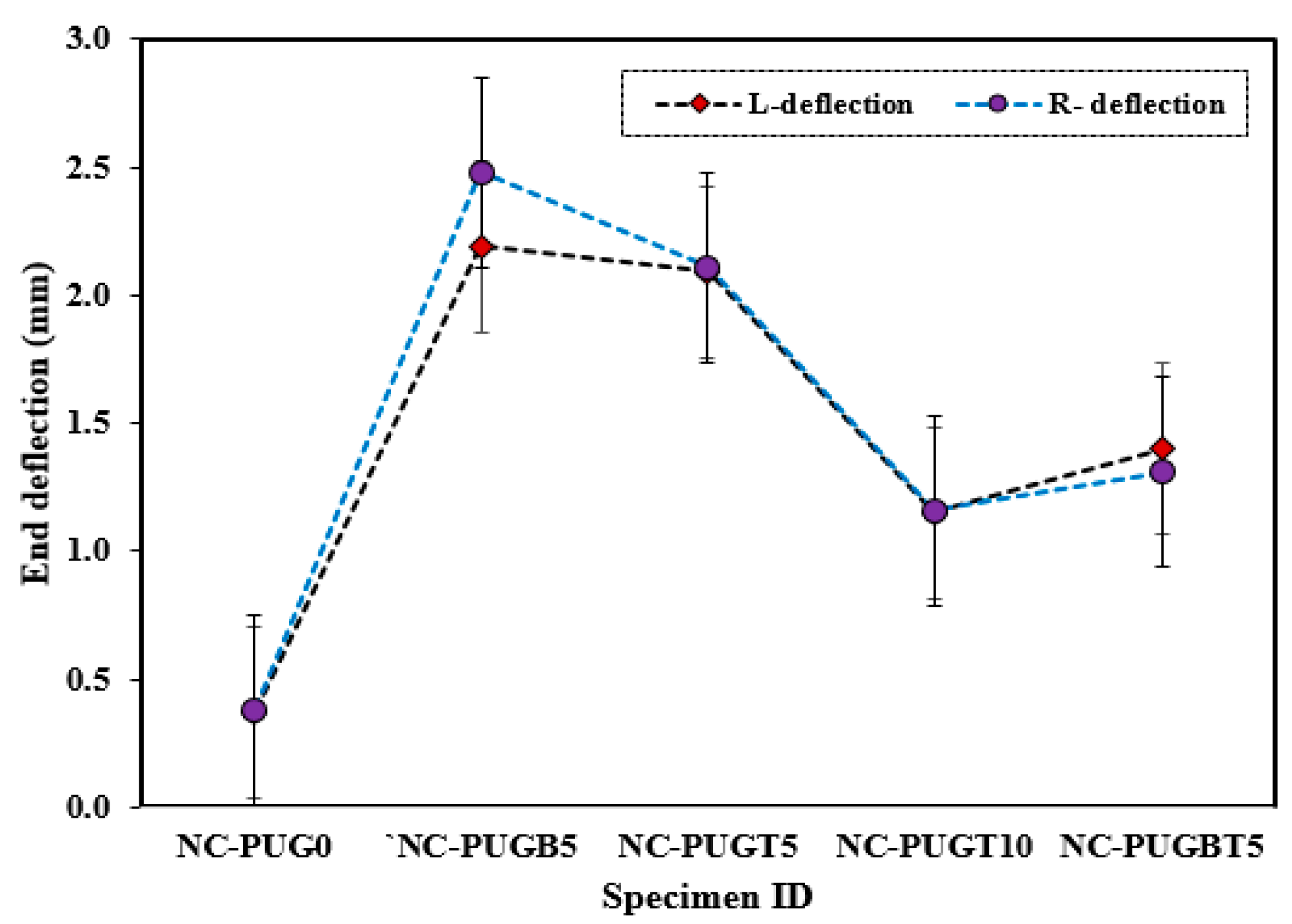
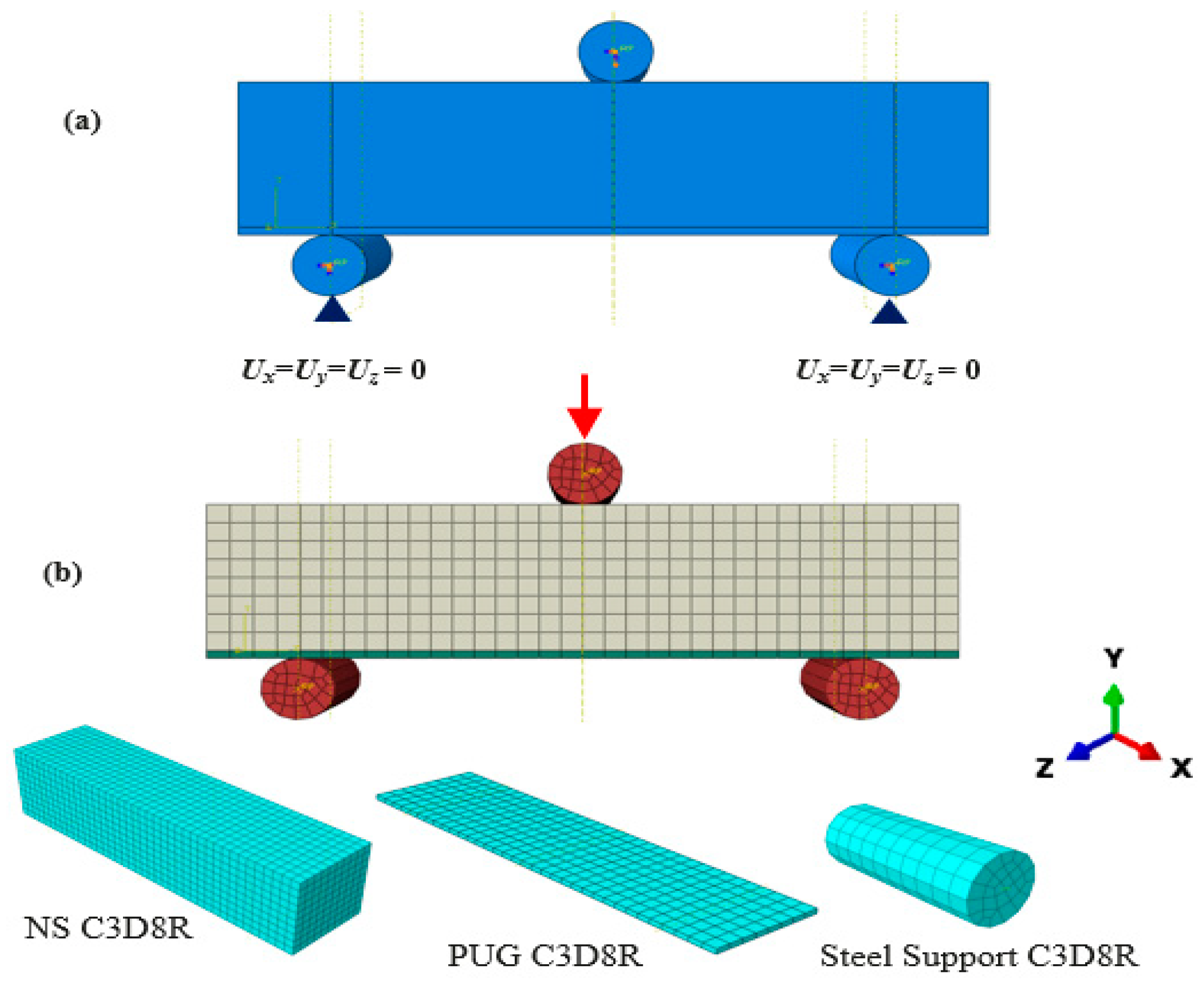
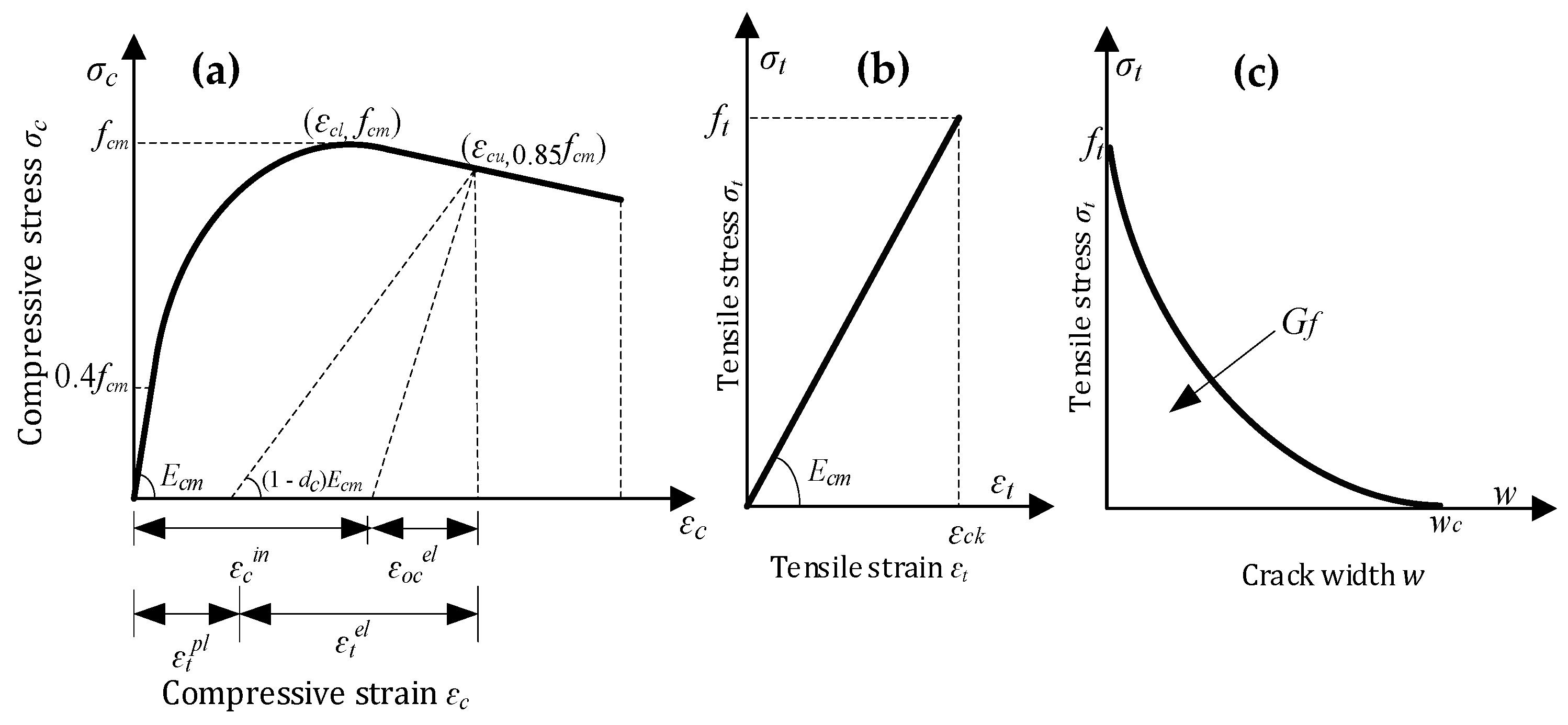
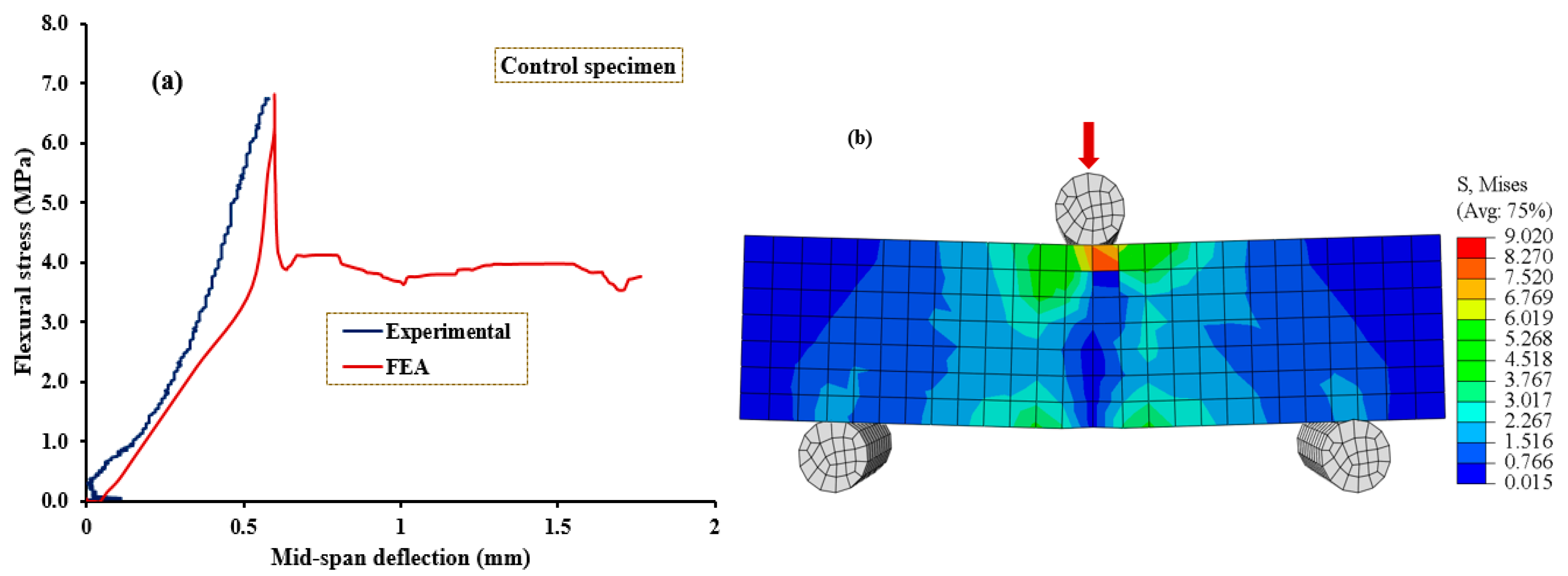
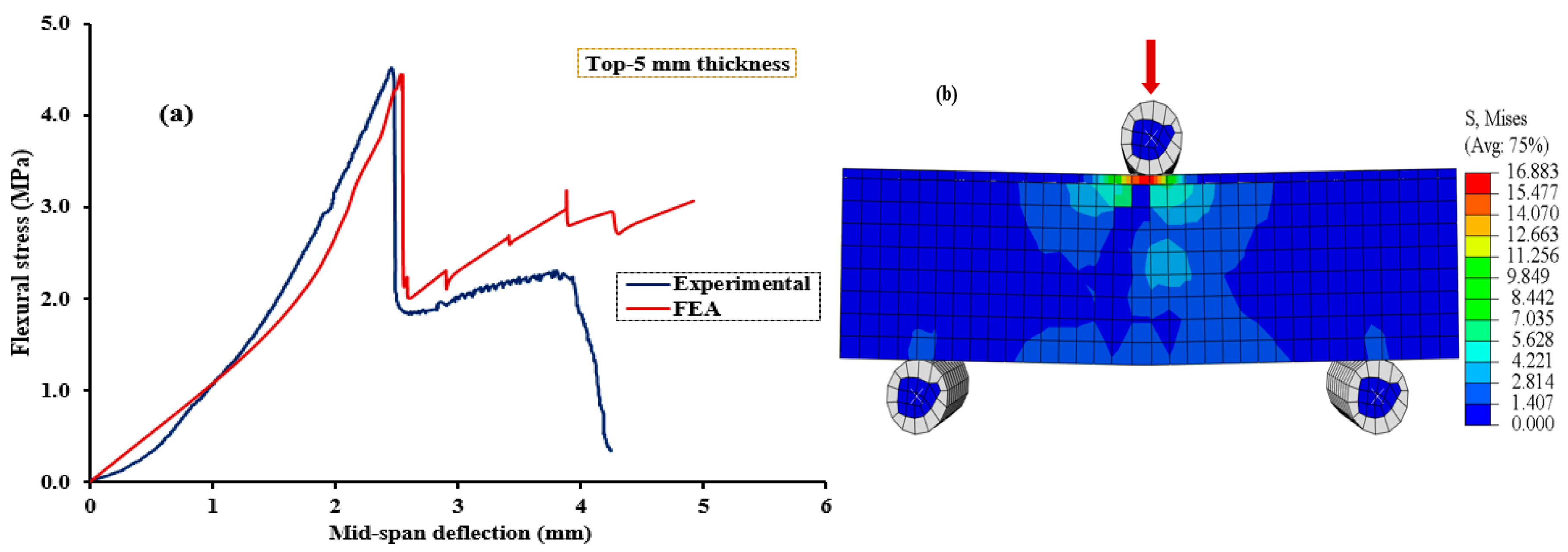

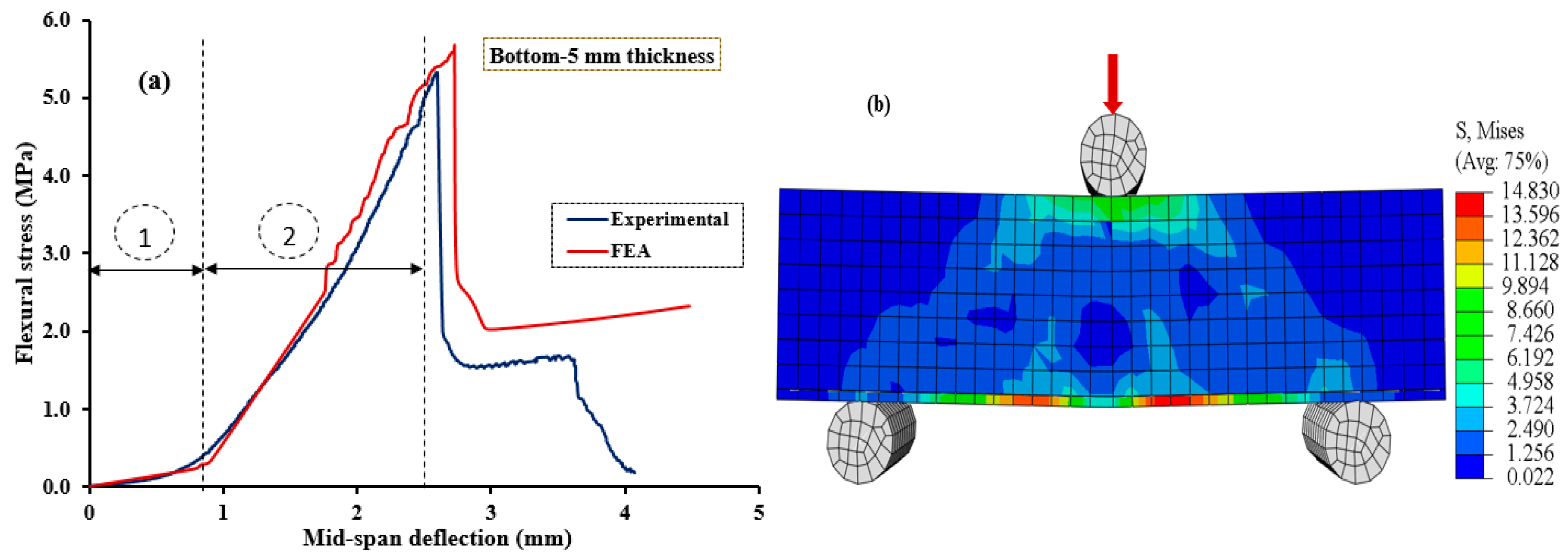


| Material | Oxides | |||||||||
|---|---|---|---|---|---|---|---|---|---|---|
| SiO2 | Al2O3 | Fe2O3 | CaO | MgO | K2O | Na2O | SO3 | TiO2 | LOI | |
| Cement | 23.27 | 4.41 | 2.45 | 62.85 | 1.42 | 0.48 | 0.21 | 2.57 | 0.08 | 1.82 |
| PU Materials | Viscosity (CPS) | Appearance | Curing Age (h) | Tension Property (MPa) | |
|---|---|---|---|---|---|
| Initial | Final | ||||
| Castor oil | 35,000 | Grey/white sticky | - | - | - |
| PAPI | 250 | Brown transparent | - | - | - |
| PU binder | - | - | 3.5 | 72 | 5.5 |
| Mix ID | Cement (kg/m3) | Sand (kg/m3) | Coarse aggregate (kg/m3) | Water (kg/m3) |
| NC | 425 | 718 | 966 | 170 |
| PU/Quartz sand (weight ratio) | PU binder (200 g) | |||
| Castor oil (g) | PAPI (g) | Solvent (g) | ||
| PU grout | 1:0.5 | 167 | 33 | 8.4 |
| Sample ID | Sample Type | Sample Designation | PU Grout Layer Thickness (mm) | |
|---|---|---|---|---|
| Top Surface | Bottom Surface | |||
| NC-PUG0 |  | - | - | - |
| NC-PUGT5 |  | T | 5 | - |
| NC-PUGB5 |  | B | - | 5 |
| NC-PUGTB5 |  | T&B | 5 | 5 |
| NC-PUGT10 |  | T | 10 | - |
| Specimen ID | Code | Flexural Strength (MPa) | L-Deflection (mm) | Max Deflection (mm) | R-Deflection (mm) |
|---|---|---|---|---|---|
| Reference | 1 | 5.478 | 0.42 | 0.57 | 0.42 |
| 2 | 5.746 | 0.36 | 0.43 | 0.34 | |
| 3 | 5.478 | 0.35 | 0.47 | 0.38 | |
| Confidential level (0.95) | 5.56 ± 2.57% | 0.38 ± 9.29% | 0.49 ± 13.60% | 0.38 ± 9.73% | |
| NC-PUGB5 | 1 | 4.371 | 2.07 | 2.46 | 2.71 |
| 2 | 4.32 | 2.2 | 2.60 | 2.43 | |
| 3 | 4.21 | 2.32 | 2.56 | 2.30 | |
| Confidential level (0.95) | 4.30 ± 1.77% | 2.19 ± 5.26% | 2.54 ± 2.62% | 2.48 ± 7.81% | |
| NC-PUGT5 | 1 | 3.662 | 2.32 | 2.46 | 2.42 |
| 2 | 3.174 | 1.73 | 1.81 | 1.71 | |
| 3 | 3.330 | 2.24 | 2.22 | 2.21 | |
| Confidential level (0.95) | 3.39 ± 6.80% | 2.09 ± 14.10% | 2.16 ± 14.04% | 2.11 ± 15.95% | |
| NC-PUGT10 | 1 | 3.723 | 1.35 | 1.34 | 1.24 |
| 2 | 3.702 | 0.97 | 1.1 | 1.04 | |
| 3 | 3.46 | 1.14 | 1.36 | 1.21 | |
| Confidential level (0.95) | 3.63 ± 3.72% | 1.15 ± 15.25% | 1.27 ± 10.55% | 1.16 ± 8.57% | |
| NC-PUGTB5 | 1 | 4.440 | 1.38 | 1.48 | 1.27 |
| 2 | 4.155 | 1.43 | 1.2 | 1.28 | |
| 3 | 4.67 | 1.40 | 1.45 | 1.39 | |
| Confidential level (0.95) | 4.35 ± 3.62% | 1.40 ± 1.66% | 1.38 ± 10.32% | 1.31 ± 4.68% |
| Material | Compressive Strength (MPa) | Elastic Modulus (GPa) | Tensile Strength (MPa) | Density (kg/m3) |
|---|---|---|---|---|
| NC (C50) | 48.67 | 32.29 | 4.76 | 2400 |
| PUG | 19.89 | 36.67 | 14.29 | 2400 |
| No. | Specimens | Ke kN/mm | KN kN/mm | Pu (kN) | PN (kN) | Ke/KN | Pu/PN |
|---|---|---|---|---|---|---|---|
| 1 | NC | 22.880 | 18.511 | 18.260 | 18.427 | 1.230 | 0.991 |
| 2 | NC-PUGB5 | 3.661 | 3.963 | 14.400 | 15.365 | 0.924 | 0.937 |
| 3 | NC-PUGT5 | 7.914 | 7.585 | 12.340 | 12.788 | 1.048 | 0.964 |
| 4 | NC-PUGT10 | 3.541 | 3.275 | 12.210 | 12.034 | 1.081 | 1.014 |
| 5 | NC-PUGBTB5 | 6.038 | 6.245 | 13.850 | 14.100 | 0.966 | 0.982 |
| Standard deviation | 7.221 | 5.519 | 2.194 | 2.251 | 0.106 | 0.026 | |
| Mean | 8.807 | 7.916 | 14.212 | 14.543 | 1.049 | 0.977 | |
| Cov (%) | 82 | 69.7 | 15.4 | 15.5 | 10.1 | 2.6 |
Disclaimer/Publisher’s Note: The statements, opinions and data contained in all publications are solely those of the individual author(s) and contributor(s) and not of MDPI and/or the editor(s). MDPI and/or the editor(s) disclaim responsibility for any injury to people or property resulting from any ideas, methods, instructions or products referred to in the content. |
© 2023 by the authors. Licensee MDPI, Basel, Switzerland. This article is an open access article distributed under the terms and conditions of the Creative Commons Attribution (CC BY) license (https://creativecommons.org/licenses/by/4.0/).
Share and Cite
Haruna, S.I.; Ibrahim, Y.E.; Han, Z.; Farouk, A.I.B. Flexural Response of Concrete Specimen Retrofitted with PU Grout Material: Experimental and Numerical Modeling. Polymers 2023, 15, 4114. https://doi.org/10.3390/polym15204114
Haruna SI, Ibrahim YE, Han Z, Farouk AIB. Flexural Response of Concrete Specimen Retrofitted with PU Grout Material: Experimental and Numerical Modeling. Polymers. 2023; 15(20):4114. https://doi.org/10.3390/polym15204114
Chicago/Turabian StyleHaruna, Sadi Ibrahim, Yasser E. Ibrahim, Zhu Han, and Abdulwarith Ibrahim Bibi Farouk. 2023. "Flexural Response of Concrete Specimen Retrofitted with PU Grout Material: Experimental and Numerical Modeling" Polymers 15, no. 20: 4114. https://doi.org/10.3390/polym15204114
APA StyleHaruna, S. I., Ibrahim, Y. E., Han, Z., & Farouk, A. I. B. (2023). Flexural Response of Concrete Specimen Retrofitted with PU Grout Material: Experimental and Numerical Modeling. Polymers, 15(20), 4114. https://doi.org/10.3390/polym15204114








